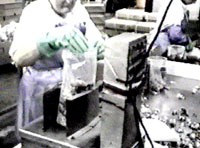







|
Evisceration
Task 11: Bagger
 A
bagger bulk packs hearts, livers, or gizzards into various sized bags
before the bags are placed into boxes for shipment. Baggers may
also repack giblets (heart, liver, gizzard, neck) into small paper bags
for reinsertion into body cavity of whole birds. Some operations also
require these employees to move the filled bag to a sealer where the bag is closed
with a clip or heat seal. A
bagger bulk packs hearts, livers, or gizzards into various sized bags
before the bags are placed into boxes for shipment. Baggers may
also repack giblets (heart, liver, gizzard, neck) into small paper bags
for reinsertion into body cavity of whole birds. Some operations also
require these employees to move the filled bag to a sealer where the bag is closed
with a clip or heat seal.
Hazards of this task may include:
|
Repetitive pinch grips
|
Hazardous Situation:
Employees
secure and hold bags using a one- or two-finger pinch grip when removing it from the bagging fixture,
transporting
it to the bag sealer, and feeding it into the bag sealer. Using pinch grip
places significant stress on the
tendons of the fingers, which can lead to injuries of the hand, wrist and forearm.
Possible Solutions:
-
Rotate
to those jobs that use different motions and postures.
- Use
automatic bag sealers.
- Reposition bagging
fixtures and sealer heights vertically so the bag can be slid, rather
than lifted, between these areas.
Return to Top
|
|
Reaching across or up to high work surfaces
|
Hazardous Situation:
Employees repeatedly reach to bins or across table tops to
obtain product for bagging and place product in bags. Repetitive reaching stresses the shoulder and upper back.
Possible Solutions:
- Use
diverter
bars to push product closer to employee.
- Reduce width of
table so product is presented closer to employee.
-
Tilt work surface so product
slides to employee.
-
Position
bagging fixtures, bags, scales, and supplies of product so employees may maintain neutral
postures. Bagging fixture should be low enough so employee's elbows can
remain in at the side of the body.
Return to Top
|
|
Standing
for a long time
|
Hazardous Situation:
Standing for a long time reduces blood flow to the legs, forces isolated muscles to work for
an extended
time, and increases risk of fatigue and varicose veins.
Possible Solutions:
- Install
sit/stand stools, which allow
employees to lean and have their weight supported while still remaining in an upright
posture.
- Rotate
employees to tasks that do not require prolonged standing.
-
Provide
shoe insoles that cushion the feet and spread foot pressure over a larger surface.
-
Provide a foot rest
in front of employees so they can shift their posture.
Return
to Top
|
|

